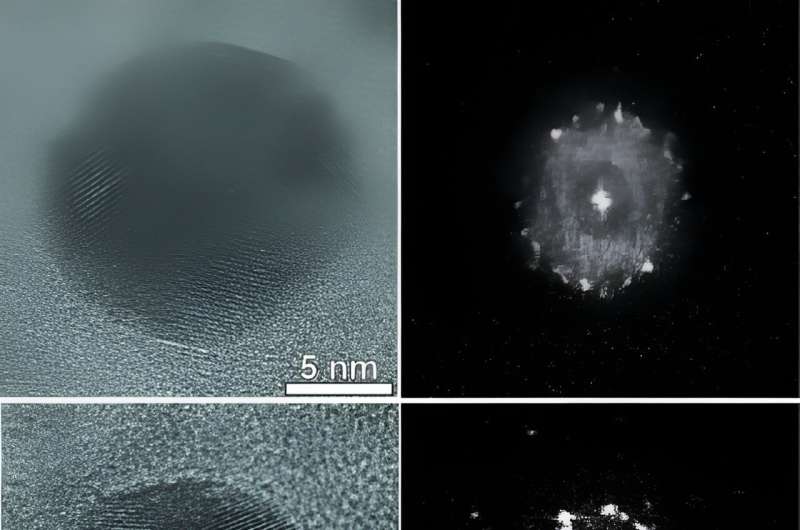High resolution transmission electron microscope images of Au nanoparticles before (above) and after (below) encapsulation. Credit: Northwestern University
Northwestern University researchers have developed a novel method to host gas molecules as they are being analyzed in real time, using honeycomb structures found in nature as inspiration for an ultra-thin ceramic membrane they incorporated to encase the sample.
In addition to inferring the signatures of gas atoms through their unique bonds, the encapsulation strategy works within high-vacuum transmission electron microscopes (TEMs) to enhance imaging of solid nanostructures. These tools can be used across the board, from national labs conducting basic research to innovative start-ups creating practical applications.
When electrons scatter away from their original path as they pass through a sample, the image resolution and contrast degrade. Designed by a team of materials scientists at Northwestern, the resulting silicon nitride microchip minimized background scattering.
"Our team has developed a membrane that's so thin that electrons can pass through the nanoreactor with minimal distraction," materials scientist Vinayak Dravid said. "We anchored an ultra-thin silicon nitride film on our honeycomb framework that gives us a cell with membranes on either side."
The paper was published Jan. 17 in the journal Science Advances.
Dravid, an author of the paper, is the Abraham Harris Professor of Materials Science and Engineering at Northwestern's McCormick School of Engineering and the founding director of the NUANCE Center, where the work was conducted. He also serves as the associate director of global initiatives at the International Institute for Nanotechnology.
Together with Xiaobing Hu, co-corresponding author and a research associate professor within materials science and engineering department, and Kunmo Koo, first author and a research associate in the NUANCE Center, the Dravid research team developed the platform for gas cells using a membrane one-fifth as thick as commercially available microchips.
The before-and-after images displaying the reactions were striking.
"The thickness of the conventional membranes tends to be very large to maintain the mechanical integrity under the extremely high vacuum the microscope creates," Dravid said. "Imagine I had to have very thick glasses that absorb a lot of light and, as a result, I don't see much. The images we produced with our invention look almost like unfogging the glasses."
Dravid compared the difference to that of the James Webb Space Telescope, in which previously invisible bodies came into focus. Importantly, the membrane allowed the team to use spectroscopy to do an analysis "down to a handful of gas atoms"—discerning, for example, a difference between previously identical-looking molecules like carbon dioxide (CO2) and carbon monoxide (CO), which are critical in emerging clean energy technologies.
Spectroscopy allows researchers to see how electrons interact with the atoms they are imaging, seeing how they absorb, reflect or emit specific energies while revealing a unique spectroscopy fingerprint.
More information: Kunmo Koo et al, Ultrathin silicon nitride microchip for in situ/operando microscopy with high spatial resolution and spectral visibility, Science Advances (2024). DOI: 10.1126/sciadv.adj6417
Journal information: Science Advances
Provided by Northwestern University























